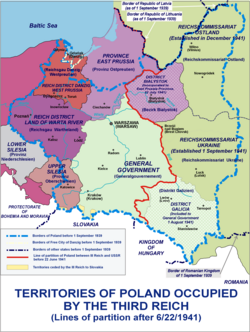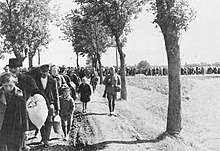Reichsgau Wartheland
| Reichsgau Wartheland Warthegau | |||||||||
|---|---|---|---|---|---|---|---|---|---|
| Reichsgau of Nazi Germany | |||||||||
| 1939–1945 | |||||||||
 Map of Nazi conquest showing administrative subdivisions (Gaue and Reichsgaue) with Warthegau area (bright yellow, right).  Reichsgau Wartheland (burgundy) on the map of occupied Poland | |||||||||
| Capital | Posen | ||||||||
| Government | |||||||||
| Gauleiter | |||||||||
• 1939–1945 | Arthur Greiser | ||||||||
| History | |||||||||
| 8 October 1939 | |||||||||
| 1 August 1945 | |||||||||
| |||||||||
| Today part of | Poland | ||||||||
The Reichsgau Wartheland (initially Reichsgau Posen, also Warthegau) was a Nazi German Reichsgau formed from parts of Polish territory annexed in 1939 during World War II. It comprised the region of Greater Poland and adjacent areas. Parts of Warthegau matched the similarly named pre-Versailles Prussian province of Posen. The name was initially derived from the capital city, Posen (Poznań), and later from the main river, Warthe (Warta).
During the Partitions of Poland from 1793, the bulk of the area had been annexed by the Kingdom of Prussia until 1807 as South Prussia. From 1815 to 1849, the territory was within the autonomous Grand Duchy of Posen, which was the Province of Posen until Poland was re-established in 1918–1919 following World War I. The area is currently the Greater Poland Voivodeship.
Invasion and occupation of Poland

After the German Wehrmacht invaded Poland in September 1939, the German Reich occupied the whole of the Greater Poland area - the erstwhile Polish Poznań Voivodeship - and split the territory between four Reichsgaue and the General Government area (further east). The Militärbezirk Posen was created in September 1939; in accordance with a decree of 8 October 1939, Germany annexed it on 26 October 1939 as the Reichsgau Posen.[1] SS Obergruppenfuhrer Arthur Greiser became Gauleiter on 21 October.[2] He would remain in this post until the end of the war in 1945. Reichsgau Posen was renamed "Reichsgau Wartheland" on 29 January 1940.
In the new Reichsgau Posen the Wehrmacht established Wehrkreis XXI, based at Poznań (German: Posen), under the command of General der Artillerie Walter Petzel. Its primary operational unit was the 48th Panzer Korps, covering so-called Militärische Unterregion-Hauptsitze including Posen (Polish: Poznań), Lissa (Polish: Leszno), Hohensalza (Polish: Inowrocław), Leslau (Polish: Włocławek), Kalisch (Polish: Kalisz), and Litzmannstadt (Polish: Łódź). It maintained training areas at Sieradz and Biedrusko.
The territory of the Reichsgau was inhabited predominantly by ethnic Poles, by Germans (a minority of 16.7% in 1921), and by Polish Jews. Most of the Jewish residents were eventually imprisoned at the Łódź Ghetto (officially established in December 1939) and exterminated at Chełmno extermination camp (German: Vernichtungslager Kulmhof, operational from December 1941 onwards).[3]
Characteristics

The Gauleiter and Reichsstatthalter of Reichsgau Wartheland, native-born Arthur Greiser,[4] embarked on a program of complete removal of the formerly Polish citizenry upon his nomination by Heinrich Himmler.[5] The plan also entailed the re-settling of ethnic Germans from the Baltic and other regions into farms and homes formerly owned by Poles and Jews.[6] He also authorized the clandestine operation of exterminating 100,000 Polish Jews (about one-third of the total Jewish population of Wartheland),[7] in the process of the region's complete "Germanization".[8] In the first year of World War II, some 630,000 Poles and Jews were forcibly removed from Wartheland and transported to the occupied General Government (more than 70,000 from Poznań alone) in a series of operations called the Kleine Planung covering most Polish territories annexed by Germany at about the same time. Both Poles and Jews had their property confiscated.[9]
By the end of 1940, some 325,000 Poles and Jews from the Wartheland and the Polish Corridor were expelled to General Government, often forced to abandon most of their belongings.[10] Fatalities were numerous. In 1941, the Nazis expelled a further 45,000 people, and from autumn of that year, they began killing Jews by shooting and in gas vans, at first spasmodically and experimentally.[11] Reichsgau Wartheland had the population: 4,693,700 by 1941. Greiser wrote in November 1942: "I myself do not believe that the Führer needs to be asked again in this matter, especially since at our last discussion with regard to the Jews he told me that I could proceed with these according to my own judgement."[12]

End of war
By 1945 nearly half a million Germanic Volksdeutsche had been resettled in the Warthegau alone among the areas annexed by Germany while the Soviet forces began to push the retreating German forces back through the Polish lands. Most German residents along with over a million colonists fled westward. Some did not, due to restrictions by Germany's own government and the quickly advancing Red Army. An estimated 50,000 refugees died from the severe winter conditions, others as war atrocities committed by the Soviet military.[citation needed] The remaining ethnically German population was expelled to new Germany after the war ended.[14]
See also
- History of Poland (1939–1945)
- World War II atrocities in Poland
- Special Prosecution Book-Poland
- Intelligenzaktion
- Volksdeutscher Selbstschutz
Notes
- ^
Neuburger, Otto (1944) [1943]. "Gazettes of the Länder and Reichsgaue". Official Publications of Present-day Germany: Government, Corporate Organizations and National Socialist Party, with an Outline of the Governmental Structure of Germany. Washington: U.S. Government Printing Office. p. 82. Retrieved 5 April 2024.
Reincorporated into Germany on October 26, 1939 as Reichsgau Posen by decree of October 8, 1939 (RGBl,I, p 2041).
- ^ Michael D. Miller and Andreas Schulz (2012). Gauleiter: The Regional Leaders of the Nazi Party and Their Deputies, 1925-1945, Vol. 1. R. James Bender Publishing. p. 360. ISBN 978-1-932970-21-0.
- ^ HolocaustHistory.org: "ninety-seven thousand have been processed, using three vans, without any defects showing up in the vehicles." Postwar testimony Obersturmbannführer August Becker, the gas-van inspector. See: Ernst Klee; Willi Dressen; Volker Riess (1991). "A new and better method of killing had to be found: The gas-vans". The Good Old Days: The Holocaust As Seen by Its Perpetrators and Bystanders. Old Saybrook, Connecticut: Konecky & Konecky. pp. 69–70. ISBN 1-56852-133-2. Also in: Christopher Browning (2000), Evidence for the Implementation of the Final Solution with archives of the RSHA.
- ^ Ian Kershaw (2013). Hitler 1936-1945. Penguin UK. p. vi. ISBN 978-0-14-190959-2.
- ^ "Poles: Victims of the Nazi Era". United States Holocaust Memorial Museum. Retrieved 24 May 2013.
- ^ Lynn H. Nicholas, Cruel World: The Children of Europe in the Nazi Web pp. 207-9, ISBN 0-679-77663-X.
- ^ "Special treatment" (Sonderbehandlung)". The Holocaust History Project. Archived from the original on 2013-05-28.
- ^ Main Commission for Investigation of German Crimes in Poland, German Crimes in Poland (Warsaw: 1946, 1947); Archive of Jewish Gombin Genealogy, with introduction by Leon Zamosc. Note: The Main (or Central) Commission for Investigation of German Crimes in Poland (Polish: Główna Komisja Badania Zbrodni Niemieckich w Polsce, GKBZNwP) founded in 1945 was the predecessor of the Institute of National Remembrance (see also the "Archived copy". Archived from the original on February 12, 1997. Retrieved 2017-01-12.
{{cite web}}: CS1 maint: archived copy as title (link)). Quote: "The creation of the Main Commission... was preceded by work done in London since 1943 by the Polish Government in Exile." - ^ Agency for the East that oversaw the registration, administration and eventual sale of all property confiscated from Poles and Jews (virtually all Polish and Jewish property was confiscated)Heimat, Region, and Empire: Spatial Identities under National Socialism Claus-Christian W. Szejnmann, Maiken Umbach
- ^ Lynn H. Nicholas, Cruel World: The Children of Europe in the Nazi Web pp. 213-214, ISBN 0-679-77663-X.
- ^ Max Hastings, "The Most Evil Emperor," NYRB October 23, 2008, p. 48.
- ^ Ian Kershaw, Hitler, the Germans, and the Final Solution (Yale University Press, 2008), p. 75.
- ^ R. M. Douglas (2012). Orderly and Humane: The Expulsion of the Germans after the Second World War. Yale University Press. p. 21. ISBN 978-0-300-18376-4.
In a keynote address to the Reichstag to mark the end of the 'Polish campaign', on October 6, 1939, Hitler announced the Heim ins Reich (Back to the Reich) program. The prospect of being uprooted from their homes to face an uncertain future not even in Germany proper, but in the considerably less salubrious environment of western Poland, was greeted with a deep sense of betrayal.
- ^ Norman M. Naimark, The Russians in Germany. p. 75. ISBN 0674784057.
Sources
- Shoa.de - List of Gaue and Gauleiter (in German)
- Die NS Gaue at the Deutsches Historisches Museum website (in German)
- Die Gaue der NSDAP (in German)
Further reading
- Huener, Jonathan (University of Vermont) (March 2014). "Nazi Kirchenpolitik and Polish Catholicism in the Reichsgau Wartheland, 1939–1941". Central European History. 47 (1). Central European History Society of the American Historical Association: 105–137. doi:10.1017/S0008938914000648. S2CID 145194931. - DOI 10.1017/S0008938914000648, online publication on 15 May 2014


